AC3. Cosmic Engines
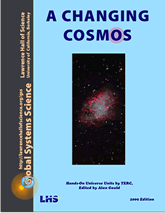
Chapter 3
At the beginning of this book, two of the three ways to “end life as we know it” were caused by dramatic changes that can happen at the end of star’s life, when it can swell up to enormous size in a red giant stage, or blow up in a supernova explosion.
The beginning of a star’s life happens in a gigantic cloud of gas (nebula), many examples of which are found in Charles Messier’s catalog that we spoke of in the Investigation Using Star Maps in the previous chapter.
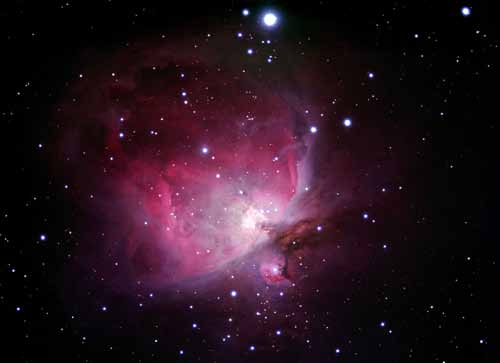
The way that a nebula becomes a star is by the gravity force from each individual particle in the gas cloud acting on other particles causing the whole cloud to contract and shrink in size. In that process, particles move faster and faster as the cloud shrinks. Faster moving molecules means hotter and hotter gas. This gravitationally generated heat energy is one of the fundamental “engines” of cosmic energy. When the gas gets to a certain “magic” temperature and pressure, and amazing thing happens—atoms start transforming and a star is born. A good place to study this is in the nearest star to us: our own Sun!
I. What Is the Secret of the Sun’s Furnace?
Using instruments called spectrometers that analyze the color of light from the Sun, astronomers found that it is composed mostly of hydrogen (70%) and helium (28%). Just 2% of the Sun is composed of heavier elements, and almost none of it is of the variety that will generate energy by radioactive decay.
In 1920, at a meeting of the British Association for the Advancement of Science, Sir Arthur Eddington, who was already a famous English physicist, speculated about the source of energy that powered the Sun. His idea turned out to be an amazingly accurate prediction. In his presentation, he referred to measurements that had been made by his colleague, Francis Aston, which showed that when the nuclei of four hydrogen atoms were combined, or fused, to form one nucleus of helium, a bit of matter was apparently “lost.” This fact—plus his knowledge of the Law of Conservation of Energy—is what Eddington needed to speculate about the source of energy in the Sun.
“Aston has further shown conclusively that the mass of the helium atom is even less than the masses of the four hydrogen atoms which enter into it—and in this, at any rate, the chemists agree with him. There is a loss of mass in the synthesis amounting to 1 part in 120, the atomic weight of hydrogen being 1.008 and that of helium just 4. Now mass cannot be annihilated, and the deficit can only represent the mass of the electrical energy set free in the transmutation of hydrogen into helium, other particles and a release of energy. We can therefore at once calculate the quantity of energy liberated when helium is made out of hydrogen….
“If, indeed, the sub-atomic [nuclear] energy in stars is being freely used to maintain their great furnaces, it seems to bring a little nearer to fulfillment our dream of controlling this latent power for the well-being of the human race—or for its suicide.”
—Sir Arthur Eddington, 1929
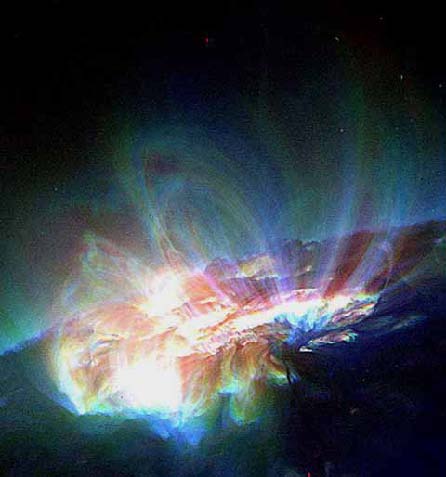
Eddington noted that the amount of energy liberated when mass is apparently “lost” can be calculated from Einstein’s famous equation:
E = mc2
This equation means that a certain amount of energy (E) is equivalent to a certain amount of mass (m) multiplied by the speed of light times itself. The speed of light is about 300,000 kilometers per second. If you could go that fast, you could go around the world seven times in a single second. This is a very large number, and when it is squared it is even bigger! So the tiny bit of mass that is lost when four hydrogen atoms combine to form one helium nucleus is converted into a relatively large amount of energy.
In the core of the Sun, about five billion kilograms of hydrogen is turned into helium every second. If 1/120 of that mass is converted to energy—that’s about 50 million kg/sec.—enough to account for the Sun’s production of energy. The Sun has been fusing hydrogen at this rate for about five billion years, and there is enough hydrogen fuel to keep the Sun “burning” for another five billion years.
The combination of four hydrogen nuclei into a single helium nucleus is called nuclear fusion. The details of this process were worked out in 1938 by Hans Bethe in the United States and Carl von Weizsacher, working independently in Germany. It is now widely accepted that this process is at work in the core of the Sun, producing the energy that we need to live.

In the late 1930’s, experimenters in the United States, England, and Germany were conducting experiments in which they created fission reactions in the laboratory. This was the time when Hitler was in power in Nazi Germany, and World War II was brewing. Scientists around the world saw the implications of nuclear power for the making of powerful weapons, and both the U.S. and Germany started research projects to create nuclear weapons. The first “atomic bombs” which used a fission reaction were dropped by U.S. warplanes on the cities of Hiroshima and Nagasaki in 1945, killing over a hundred thousand people.
A much more powerful “hydrogen bomb,” which used a fusion reaction, was exploded at test sites on Pacific Islands by the United States in the early 1950’s, and shortly thereafter by the Soviet Union. The ensuing “arms race,” which occupied the world for the next few decades, gave chilling meaning to the last words in Eddington’s speech.
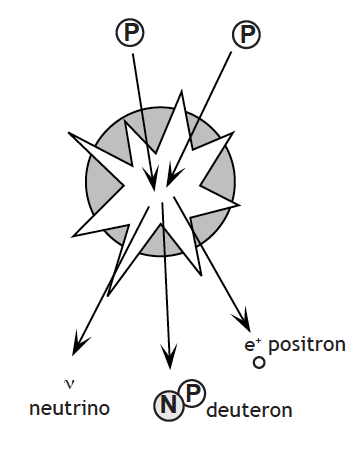
Particles involved in
nuclear reactions:
p = proton; positively charged; relatively massive; nucleus of the hydrogen atom.
n = neutron; no charge; very slightly more massive than the proton.
e- = electron; negative charge; very light (1/1840 times the mass of the proton).
e+ = positron; antiparticle to electron—same mass but positive charge.

N/P = deuteron; composed of a proton and a neutron bound together; has same positive charge as the proton; nucleus of deuterium (heavy hydrogen), an isotope of hydrogen.
n = neutrino; chargeless and very small mass, so small that it was originally thought to be 0; very little interaction with matter; can pass through a whole planet or star without interacting. [See 2015-Oct-07 article: Physics Nobel Winners Also Solved Solar Mystery.]
g = gamma ray; a photon—packet of electromagnetic energy—much like ordinary light, but with much higher energy and very short wavelength.
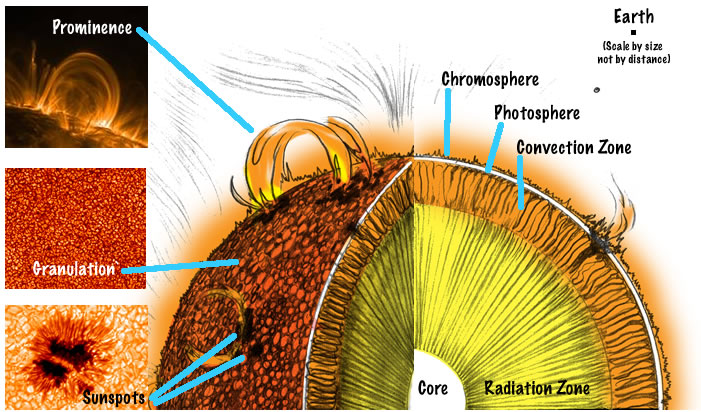

AC3.1. Investigation:
Size and Scale of the Sun
Use image processing software functions to measure the size and scale of the Sun and other stellar objects.

AC3.2. Investigation:
Plate Scale of a Smart Phone
Smartphones can be used to simulate capturing an image with a telescope. To make measurements with smartphone images, you first need to know what distance (or size-dimension) is reflected by each pixel in the image. This is known as calibrating the plate scale of the smartphone.

AC3.3. Investigation:
Sun Movement
Use the software Stellarium to plot movement of the Sun, for example throughout the day on June 21 and December 21.

AC3.4. Investigation:
Window to the Stars
“Stars for Schools” is a United Kingdom (UK) based programme about the physics at work in stars. Use professional grade software, Window to the Stars (WTTS), to generate model stars and increase your understanding of astrophysics at light speed!
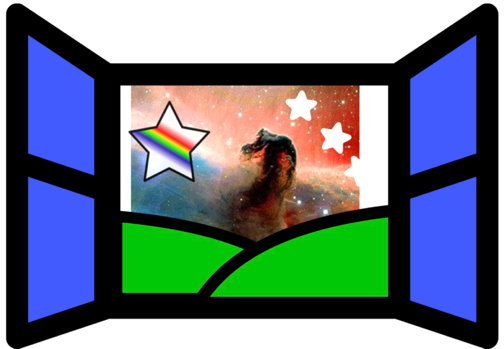
WTTS software can generate data and simulate stellar evolution in animated Hertsprung-Russell diagrams (related to Investigation 5.4 HR Diagrams of Star Clusters).
Part I
introduces the ideas of stellar astrophysics
and computer modelling.
Part II
contains ideas and exercises that help you understand the astrophysics of stars and guide you towards independent project work.
The programme works for school groups (14-18 years) but it can also be a solo project for advanced students. Assistance is provided by a team of dedicated scientists and teachers.
WTTS can be a pure educational resource or a research tool for exploring stellar evolution. Possible research titles could include:
- How could different hydrogen burning rates affect life on Earth?
- How do metallicity variations affect the evolution of a solar mass star.
- What happens to a solar mass star when coulomb forces change?
- Can Barnard’s Star be accurately modelled by inserting the known parameters into WTTS and observing its evolution?
- How much longer will Betelgeuse be a viable star?
- Study the evolution of significant internal parameters within the Sun.
- Use and interpretation of Kippenhahn Diagrams to explore structural parameters within the Sun.
- Estimate the age of the Messier 55 cluster by modelling stellar evolution with WTTS.
- Determining the stellar properties that lead to Oxygen burning.
- Using WTTS to explore the habitable zone, and hence potential for life, around Trappist-1 throughout its evolutionary history.
If you are interested in taking part, please contact the Window to the Stars team. They are happy to provide documentation, advice, and guidance. They will also introduce you to the growing WTTS community!
Core Team:
- Dr Robert Izzard – University of Surrey
- Mr Andy Brittain – Lady Eleanor Holles School
Window to the Stars email: starsforschoolswtts@gmail.com
-•-

View a partial or total solar eclipse
To see a solar eclipse, you usually have to travel to a place where the path of the Moon’s shadow sweeps across the Earth. See the Solar Eclipses page of the Pacific Planetarium Association or the Time and Date Eclipse page to the eclipse paths and more information. One way to observe a solar eclipse safely is to use a proper solar filter. See how to Make Partial Solar Eclipse Viewing Goggles.

